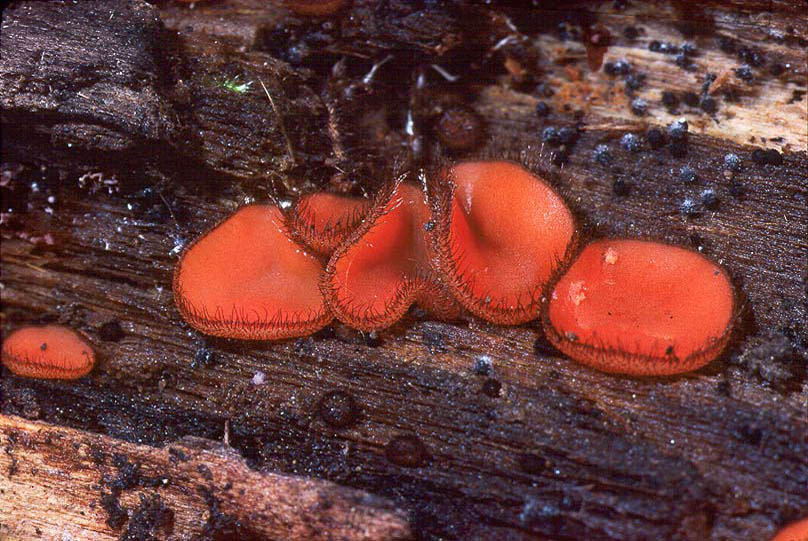H. acetabulum - little stem, but the ribs extend up the cup. Spring.
H. costifera - perhaps greyer with blunter ribs, stem buried. Spring.
Large Cups - Pezizomycetes p.p.
I am assuming that most cup fungi are saprophytic, but I don't know if that has been well studied. Exceptions of known mycorrhizal groups will be noted. Fall fruiting unless otherwise stated, but "ascos" are known for having more spring fruiters than "basidios".
Key to Large Cups:
Helvella - also found in the false morels, Helvellas are sometimes cups on a stick. The stem will be longer and thicker than in other genera (compare Plectania nannfeldtii), or short but complex and fluted. Thought to be mycorrhizal. (Compare Gyromitra, Disciotis and the black cups). Spring and fall unless noted. One ear cup fungus is now known to actually be a Helvella.
H. acetabulum - little stem, but the ribs extend up the cup. Spring.
H. costifera - perhaps greyer with blunter ribs, stem buried. Spring.
Gyromitra - also found in the false morels, but some are cup shaped without a significant stem. They are recognized by their tough, wrinkled appearance and cushion or disc shape, more so than Peziza. Thought be be saprophytic, but possibly also living a double life as mycorrhizal like the morels. Found in the spring.
Rhizina undulata - a mass of convex, irregular cups with "rhizoid" projections underneath. Spring and fall.
Disciotis venosa grp - darker than Gyromitra, often with dots under the rim and smelling like bleach. Related to Morchella, and probably mycorrhizal. Found in spring.
Colourful cups - our largest and most beautiful cup fungi. Notice the photo of Caloscypha shows the mushroom "puffing". Ascomycota will often release their spores all at once when triggered by rain or even just blowing on it a couple of times. Try it on every cup you find, and eventually it will work.
Caloscypha fulgens - <4cm, orange cup turns green where handled or in age, on the ground. Spring. Associated with firs.
Pseudaleuria quinaultiana - very similar on debris but no stem at all, orange-red, irregularly shaped. Spring.
Sarcosphaera coronaria (crassa) - somewhat buried, white inside turning purple, sphere breaking into star-shaped rays. Asci turn blue in iodine. Spring. (Molecularly, probably just a Peziza).

Scutellinia umbrarum - eyelash
rimmed red-orange cup/
S. scutellata - usually on rotten
wood, longer eyelashes.
Geopyxis deceptiva/ Black cups - blackish exterior and
interiors, usually found in the spring. (Plicaria on burned ground can be
very dark too, but is more fragile). Plectania/ Urnula/
Plectania melastoma - orange granules when young,
else black, <2.5cm across.
Bulgaria iniquinans is similar, but
gelatinous.
Donadinia nigrella (Plectania nannfeldtii) -
perfect black cup on long thin stem. Compare
Helvella. <3cm.
Pseudosarcosoma (Sarcosoma) latahense - smaller,
<5cm, young top surface somewhat purplish-black, thickened base somewhat gelatinous. Humaria/ Geopyxis/
G. deceptiva/ Peziza - fragile, brown cups on the ground, wood,
dung or burnt ground. Practically speaking, they can be very difficult to tell apart.
They may be found almost any time of year, with different species
sometimes showing a preference, but that is not always well documented. Almost
everything in the Pezizaceae family can be told by asci tips that turn a
beautiful blue in iodine under the microscope - a great way to recognize Peziza,
Plicaria,
Iodophanus or
Sarcosphaera. First, the larger Pezizas, that will grow to be between
5 and 10cm wide.
P. badia - usually dark, on the ground, resembling
Plicaria from burned ground.
P. howsei -
purple tones, on
soil or rotting wood.
P. arvernensis (sylvestris) - medium brown on the
ground or
rotting wood, external surface perhaps smoother than similar
species.
P. varia (repanda/ The following are found on burnt ground, <5cm across.
Plicaria endocarpoides - dark brown on burnt
ground, fragile like a Peziza (which it actually is), unlike
the black cups.
Plicaria trachycarpa/
Peziza echinospora (above) -
may be >5cm.
Peziza nivalis - high elevations on burnt ground near
snow, sometimes on soil or decaying grasses. Hard to ID. <2.5cm
P. sepiatra - dark brown on burn sites, <2.5cm, much
like Plicaria. Northern species.
P.
ostracoderma - similar, also on sterilized soil in gardens
and greenhouses.
P. petersii - brown,
<5cm. All are hard to ID.
P. proteana (forma sparassoides) - large convoluted clusters on
burnt ground. Sometimes does not cluster, forming individual
bodies <5cm, hard to ID. Other Pezizas...
P. badioconfusa (phyllogena) - well rotted hardwood,
northern sp., <5cm.
P. succosa - bleeds yellow juice when cut! (Soil).
P. michelii - bleeds a watery juice that
turns yellowish
P. limnaea - olive colours
P. nivalis - high elevations, usually in burned areas near snow.
<2.5cm. Otidea - lopsided cup fungi with
one side split lengthwise. Possibly confused with otherwise misshapen
cups. Usually <4cm wide. Usually found in fall. The following species look for all the world like O. smithii, but are not related,
neither are they related to each other!
Helvella (Wynnella) silvicola - also large but dark reddish brown, hard to distinguish from
O. smithii yet unrelated - it's more closely related to Helvella.
Ionomidotis (Midotis) irregularis -
resembles Otidea smithii and Wynnella, more irregularly shaped, but is
actually related to the earth tongues.
Southern species.